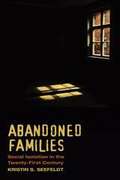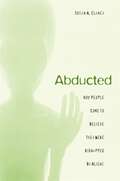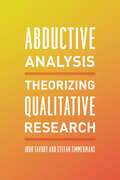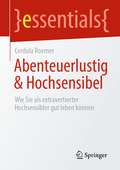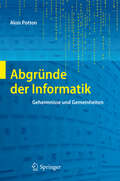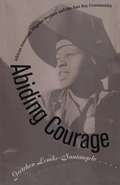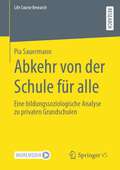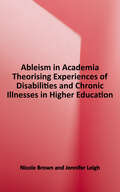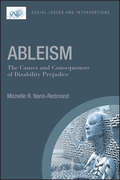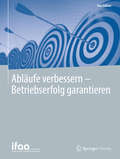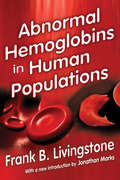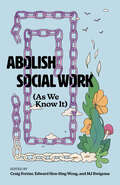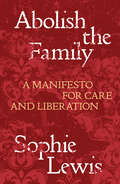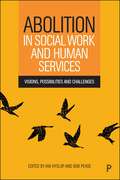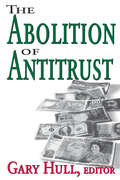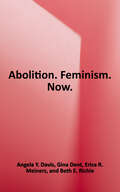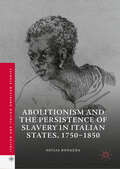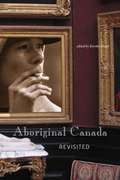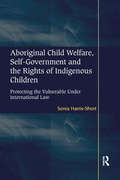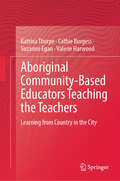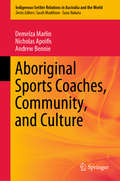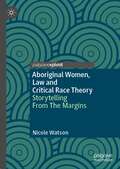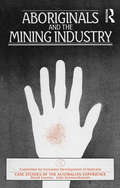- Table View
- List View
Ab 40 bewirbt man sich anders. Durchstarten mit Lebenserfahrung - Bewerbungsstrategien, Informationen, Mutmacher - mit Musterdokumenten: Durchstarten Mit Lebenserfahrung  Bewerbungsstrategien, Informationen, Mutmacher  Mit Musterdokumenten
by Anita EggertAnlässe für Menschen ab 40, sich neu zu bewerben, gibt es viele: Eine Stellenanzeige reizt zu einem beruflichen Neustart, nach einer Erziehungspause steht der Wiedereinstieg an o. ä. Das Buch unterstützt Bewerber, indem es einen systematischen Überblick über alle Phasen gibt: von der Stellensuche über das Telefoninterview bis zum Bewerbungsgespräch. Die Autorin liefert die wichtigsten Tipps für eine zeitgemäße und korrekte Bewerbung sowie Hilfen, um zu einer selbstbewussten inneren Haltung zu finden. Begleitende Website mit Arbeitsmaterialien.
Ab 40 bewirbt man sich anders: Durchstarten mit Lebenserfahrung, Bewerbungsstrategien, Informationen, Mutmacher: mit Musterdokumenten
by Anita EggertEs gibt viele gute Gründe, sich mit ,,über 40" auf dem Arbeitsmarkt zu bewerben! - Doch vieles ist dann nicht mehr so selbstverständlich wie damals nach der Ausbildung und es tauchen Fragen auf: Wo finde ich eigentlich heutzutage Jobs? Wie bewerbe ich mich zeitgemäß? Wie bringe ich einen roten Faden in meinen Lebenslauf? Wie vermittele ich einen professionellen Eindruck? Anita Eggert begleitet Sie im Bewerbungsprozess und hilft Ihnen, eine selbstbewusste Einstellung zu entwickeln, Ihr Profil zu schärfen und einen erfolgreichen Schlachtplan zu entwickeln. Ihr Buch gibt Tipps für alle Phasen der Bewerbung, von der Stellensuche über das Telefoninterview bis zum Bewerbungsgespräch, liefert Fakten für eine individuelle, zeitgemäße und korrekte Bewerbung und Hilfen für ein überzeugendes Auftreten. - NEU in der 2. Auflage sind Infos zu Arbeitgeber-Bewertungsportalen im Internet, dem richtigen Outfit in Vorstellungsgesprächen sowie neuen Smartphone-Apps. Auf der begleitenden Website www. ab-40-bewirbt-man-sich-anders. de finden Sie stets aktuelle Infos und praktische Arbeitsmaterialien (Lebensläufe, Checklisten und ganze neu: Motivationsanschreiben etc).
Abandoned Families: Social Isolation in the Twenty-First Century
by Kristin S. SeefeldtEducation, employment, and home ownership have long been considered stepping stones to the middle class. But in Abandoned Families, social policy expert Kristin Seefeldt shows how many working families have access only to a separate but unequal set of poor-quality jobs, low-performing schools, and declining housing markets which offer few chances for upward mobility. Through in-depth interviews over a six-year period with women in Detroit, Seefeldt charts the increasing social isolation of many low-income workers, particularly African Americans, and analyzes how economic and residential segregation keep them from achieving the American Dream of upward mobility. Seefeldt explores the economic and political obstacles that have altered the pathways for opportunity. She finds that while many low-income individuals work, enroll in higher education, and attempt to use social safety net benefits in times of crisis, they primarily have access to subpar institutions, which often hamper their efforts to get ahead. Many of these workers hold unstable, low-paying service sector jobs that provide few paths for advancement and exacerbate their social isolation. Those who pursue higher education to gain qualifications for better paying jobs often enroll in for-profit schools and online programs that push them into debt but rarely lead to secure employment or even a degree. And while home ownership was once the best way to establish wealth, Seefeldt finds that in declining cities like Detroit, it can saddle low-income owners with underwater mortgages in depopulated neighborhoods. Finally, she shows that the 1996 federal welfare reform and other retrenchments in the social safety net have made it more difficult for struggling families to access public benefits that could alleviate their economic hardships. When benefits are difficult to access, families often take on debt as a way of managing. Taken together, these factors contribute to what Seefeldt calls the “social abandonment” of vulnerable families. Abandoned Families is a timely, on-the-ground assessment of hardship in contemporary America. Seefeldt exposes the shortcomings of the institutions that once fostered upward mobility and shows how sweeping policy measures—including new labor protections, expansion of the social safety net, increased regulation of for-profit colleges, and reparations—could help lift up those who have fallen behind.
Abducted: How People Come to Believe They Were Kidnapped by Aliens
by Susan A. ClancyThey are tiny. They are tall. They are gray. They are green. They survey our world with enormous glowing eyes. To conduct their shocking experiments, they creep in at night to carry humans off to their spaceships. Yet there is no evidence that they exist at all. So how could anyone believe he or she was abducted by aliens? Or want to believe it? To answer these questions, psychologist Susan Clancy interviewed and evaluated "abductees"--old and young, male and female, religious and agnostic. She listened closely to their stories--how they struggled to explain something strange in their remembered experience, how abduction seemed plausible, and how, having suspected abduction, they began to recollect it, aided by suggestion and hypnosis. Clancy argues that abductees are sane and intelligent people who have unwittingly created vivid false memories from a toxic mix of nightmares, culturally available texts (abduction reports began only after stories of extraterrestrials appeared in films and on TV), and a powerful drive for meaning that science is unable to satisfy. For them, otherworldly terror can become a transforming, even inspiring experience. "Being abducted," writes Clancy, "may be a baptism in the new religion of this millennium." This book is not only a subtle exploration of the workings of memory, but a sensitive inquiry into the nature of belief.
Abductive Analysis: Theorizing Qualitative Research
by Stefan Timmermans Iddo TavoryIn Abductive Analysis, Iddo Tavory and Stefan Timmermans provide a new navigational map for theorizing qualitative research. They outline a way to think about observations, methods, and theories that nurtures theory formation without locking it into predefined conceptual boxes. The book provides novel ways to approach the challenges that plague qualitative researchers across the social sciences—how to conceptualize causality, how to manage the variation of observations, and how to leverage the researcher’s community of inquiry. Abductive Analysis is a landmark work that shows how a pragmatist approach provides a productive and fruitful way to conduct qualitative research.
Abenteuerlustig & Hochsensibel: Wie Sie als extravertierter Hochsensibler gut leben können (essentials)
by Cordula RoemerAgil, gesellig und empfindsam? Hochsensibilität gilt allgemein als eine eher introvertierte Veranlagung. Dennoch gibt es feinfühlige Menschen, die sowohl empfindsam sind und sich zugleich extravertiert durch das Leben bewegen. Wie aber passt dies beides zusammen? Schließen sich die beiden Wesenszüge nicht einander aus? Diesen und weiteren Fragen folgt die Autorin in einem kritischen Diskurs, um mehr Klarheit in den Dschungel unterschiedlicher Zuschreibungen und Erklärungen zu bringen. Dieser Diskurs möchte dazu beitragen, die Gefahr einer möglichen Fehlinterpretation im Rahmen einer fachspezifischen Begleitung in Beratung, Coaching und Therapie bei hochsensiblen Menschen zu verringern. Der zweite Teil des Buches gibt Ihnen umfangreiche und vielfältige Tipps und Methoden zum Umgang mit einer extravertierten Hochsensibilität an die Hand.
Abgründe der Informatik: Geheimnisse und Gemeinheiten
by Alois PottonWas Sie schon immer über die Informatik und "die Informatiker" wissen wollten, aber nie zu fragen wagten, Alois Potton hat es notiert: Über mehr als zwei Jahrzehnte hat er hinter die Kulissen geblickt und Anekdoten in 80 Glossen gegossen. Schonungslos, bösartig und zum Teil politisch nicht ganz korrekt analysiert er den alltäglichen Wahnsinn und die Absurditäten der IT-Szene. Allgemein verständlich geschrieben, werden sich auch Nichtinformatiker angesichts analoger Vorgänge in ihrem Arbeitsbereich amüsieren - oder aber beleidigt fühlen.
Abkehr von der Schule für alle: Eine bildungssoziologische Analyse zu privaten Grundschulen (Life Course Research)
by Pia SauermannVor dem Hintergrund eines expandierenden Privatschulsektors einerseits und der Konzeption der für allen gemeinsamen Grundschule andererseits untersucht die vorliegende Arbeit, ob private Grundschulen in Deutschland Bildungsungleichheiten verstärken. Betrachtet werden einerseits die Selektivität der Privatschulwahl und andererseits die Effekte, welche der Besuch einer privaten Grundschule auf die Kompetenzentwicklung hat. Beide Aspekte werden auf Basis von Daten des Nationalen Bildungspanels untersucht. Die Befunde weisen darauf hin, dass die Wahl einer privaten Grundschule insbesondere in städtischen Gebieten und in Ostdeutschland vom Bildungsniveau und vom kulturellen Kapital der Eltern abhängt. Wird die soziale Selektivität der Privatschulwahl berücksichtigt, zeigt sich kein Effekt privater Beschulung auf die Entwicklung von Lese- und Mathematikkompetenzen.
Ableism in Academia: Theorising Experiences of Disabilities and Chronic Illnesses in Higher Education
by Jennifer Leigh Nicole BrownRather than embracing difference, academic ecosystems seek to normalize and homogenize ways of working and of being a researcher. As a consequence, ableism is an endemic experience in academia, though to date no attempt has been made to theorize those experiences. Ableism in Academia provides an interdisciplinary outlook on ableism that is currently missing. Through reporting research data and exploring personal experiences, the contributors explore the concept of what it means to be and to work outside the so-called norm. The volume brings together a range of perspectives, including feminism, post-structuralism, Derridean and Foucauldian theory, crip theory, and disability theory, and draws on a number of related disciplines. Contributors use various schools of theory to raise awareness and increase understanding of the marginalized. These theories are placed in the context of neoliberal academia and used to interrogate aspects of identity and how disability is performed, and to argue that ableism is not just a disability issue. This timely collection will be of interest to researchers in disability studies, higher education studies, and sociology, as well as to those working across the social sciences.
Ableism: The Causes and Consequences of Disability Prejudice (Contemporary Social Issues)
by Michelle R. Nario-RedmondThe first comprehensive volume to integrate social-scientific literature on the origins and manifestations of prejudice against disabled people Ableism, prejudice against disabled people stereotyped as incompetent and dependent, can elicit a range of reactions that include fear, contempt, pity, and inspiration. Current literature—often narrowly focused on a specific aspect of the subject or limited in scope to psychoanalytic tradition—fails to examine the many origins and manifestations of ableism. Filling a significant gap in the field, Ableism: The Causes and Consequences of Disability Prejudice is the first work to synthesize classic and contemporary studies on the evolutionary, ideological, and cognitive-emotional sources of ableism. This comprehensive volume examines new manifestations of ableism, summarizes the state of research on disability prejudice, and explores real-world personal accounts and interventions to illustrate the various forms and impacts of ableism. This important contribution to the field combines evidence from multiple theoretical perspectives, including published and unpublished work from both disabled and nondisabled constituents, on the causes, consequences, and elimination of disability prejudice. Each chapter places findings in the context of contemporary theories—identifying methodological limits and suggesting alternative interpretations. Topics include the evolutionary and existential origins of disability prejudice, cultural and impairment-specific stereotypes, interventions to reduce prejudice, and how to effect social change through collective action and advocacy. Adopting a holistic approach to the study of disability prejudice, this accessibly-written volume: Provides an inclusive, up-to-date exploration of the origins and expressions of ableism Addresses how to resist ableist practices, prioritize accessible policies, and create more equitable social relations with pages earmarked for activists and allies Focuses on interpersonal and intergroup analysis from a social-psychological perspective Integrates research from multiple disciplines to illustrate critical cognitive, affective and behavioral mechanisms and manifestations of ableism Suggests future research directions based on topics covered in each chapter Ableism: The Causes and Consequences of Disability Prejudice is an important resource for social, community and rehabilitation psychologists, scholars and researchers of disability studies, and students, activists, and academics across political, sociological, and humanistic disciplines.
Abläufe verbessern - Betriebserfolg garantieren (ifaa-Edition)
by Institut für angewandte ArbeitswissenschDer Leitfaden »Abläufe verbessern – Betriebserfolg garantieren« unterstützt Führungskräfte und Mitarbeiter, Verbesserungen betrieblicher Abläufe im Alltag erfolgreich voranzutreiben und nachhaltig zu sichern. Ziele sind, den Wertschöpfungsanteil betrieblicher Abläufe stetig zu erhöhen und Verschwendung in den Produktions- und Arbeitssystemen des gesamten Unternehmens zu erkennen und zu vermeiden. Die Grundlagen hierfür sind eine klar strukturierte Vorgehensweise und die konsequente Nutzung von Zahlen, Daten und Fakten. Die Vorgehensweise berücksichtigt erfolgsrelevante Elemente bewährter Verbesserungsmethoden – wie Six Sigma, PDCA-Zyklus, 8-D Report, REFA-Planungssystematik u. a. – in pragmatischer Form. Zu den einzelnen Arbeitsschritten sind bewährte Werkzeuge in direkt anwendbarer Form verfügbar. Anschauliche Beispiele aus der Praxis ergänzen das Angebot. Seit der ersten Auflage dieses Leitfadens im Jahre 2008 haben zahlreiche Unternehmen die im Leitfaden beschriebene Vorgehensweise erfolgreich umgesetzt. Die Anwender bestätigten den Mehrwert des Leitfadens sowie ihre positiven Erfahrungen und Ergebnisse in einer begleitenden Befragung.
Abnormal Hemoglobins in Human Populations (Technical Reports #No. 3)
by Jonathan Marks Frank. B. LivingstoneResearch on abnormal human hemoglobins (protein in blood that carries oxygen), has taught us about the inheritance, biochemistry, and distribution of these traits. This knowledge, coupled with mathematical research using computer models of population genetics, has enabled researchers to marry biological fact and genetic theory. This volume places medical understanding in an evolutionary framework. Using published data on the frequencies of abnormal hemoglobins in the world's populations, Livingston analyzes and interprets these frequencies in the light of world distribution of different forms of diseases such as malaria. He further develops the genetic theory of the evolutionary homeostasis. Livingston discusses the relation of abnormal hemoglobins to endemic malaria and, shows how natural selection pressures explain the known distribution of these traits. Where non-coinciding distributions arise, the book presents other genetic, anthropological, evolutionary, and epidemiological evidence to explain these discrepancies. This classic work remains a useful sourcebook for professors and graduate students of anthropology, genetics, epidemiology, and hematology.
Abolish Social Work (As We Know It)
by Craig Fortier Edward Hon-Sing Wong Mj RwigemaAbolish Social Work (As We Know It) responds to the timely and important call for police abolition by analyzing professional social work as one alternative commonly proposed as a ready-made solution to ending police brutality. Drawing on both historical analysis and lessons learned from decades of organizing abolitionist and decolonizing practices within the field and practice of social work (including social service, community organizing, and other helping fields), this book is an important contribution in the discussion of what abolitionist social work could look like. This edited volume brings together predominantly BIPOC and queer/trans* social work survivors, community-based activists, educators, and frontline social workers to propose both an abolitionist framework for social work practice and a transformative framework that calls for the dissolution and restructuring of social work as a profession. Rejecting the practices and values encapsulated by professional social work as embedded in carceral and colonial systems, Abolish Social Work (As We Know It) moves us towards a social work framework guided by principles of mutual aid, accountability, and relationality led by Indigenous, Black, queer/trans*, racialized, immigrant, disabled, poor and other communities for whom social work has inserted itself into their lives.
Abolish the Family: A Manifesto for Care and Liberation
by Sophie LewisWhat if we could do better than the family? We need to talk about the family. For those who are lucky, families can be filled with love and care, but for many they are sites of pain: from abandonment and neglect, to abuse and violence. Nobody is more likely to harm you than your family. Even in so-called happy families, the unpaid, unacknowledged work that it takes to raise children and care for each other is endless and exhausting. It could be otherwise: in this urgent, incisive polemic, leading feminist critic Sophie Lewis makes the case for family abolition. Abolish the Family traces the history of family abolitionist demands, beginning with nineteenth century utopian socialist and sex radical Charles Fourier, the Communist Manifesto and early-twentieth century Russian family abolitionist Alexandra Kollontai. Turning her attention to the 1960s, Lewis reminds us of the anti-family politics of radical feminists like Shulamith Firestone and the gay liberationists, a tradition she traces to the queer marxists bringing family abolition to the twenty-first century. This exhilarating essay looks at historic rightwing panic about Black families and the violent imposition of the family on indigenous communities, and insists: only by thinking beyond the family can we begin to imagine what might come after.
Abolition in Social Work and Human Services: Visions, Possibilities and Challenges
by Bob Pease Ian Kelvin HyslopGlobally, social workers are committed to human rights and challenging unjust social structures. However, their close ties to the state often reinforce such systems of oppression. The first to apply abolitionist theory from international perspectives to social work, this book examines this contradiction, exploring whether social work can embrace radical change while operating within state structures. Bringing together scholars from the United States, Canada, England, Ireland, Scotland, Finland, Australia and Aotearoa New Zealand, it explores alternatives for addressing issues such as child protection, mental health, violence against women, drug use, violent extremism, homelessness and Indigenous sovereignty. Essential reading for academics, researchers, students, human service practitioners and social activists, this book interrogates the implications of social work’s complicity with systems that perpetuate oppression and social injustice.
Abolition of Antitrust
by Gary HullThe Abolition of Antitrust asserts that antitrust laws-on economic, legal, and moral grounds-are bad, and provides convincing evidence supporting arguments for their total abolition. Every year, new antitrust prosecutions arise in the U.S. courts, as in the cases against 3M and Visa/MasterCard, as well as a number of ongoing antitrust cases, such as those involving Microsoft and college football's use of the Bowl Championship Series (BCS). Gary Hull and the contributing authors show that these cases-as well as the Sherman Antitrust Act itself-are based on an erroneous interpretation of the history of American business, premised on bad economics. They equivocate between economic and political power-the power to produce versus the power to use physical force. For Hull, antitrust prosecutions are based on a horrible moral inversion: that it is acceptable to sacrifi ce America's best producers. The contributors explain how key antitrust ideas, for instance, "monopoly," "restraint of trade," and "anticompetitive behavior," have been used to justify prosecution, and then make clear why those ideas are false. They sketch the historical, legal, economic, and moral reasoning that gave rise to the passage and growth of antitrust legislation. All of the theoretical points in this volume are woven around a number of fascinating cases, both historical and current-including the Charles River Bridge, Alcoa, General Electric, and Kellogg/General Mills. Designed for the uninformed but educated layman, The Abolition of Antitrust makes positive arguments in defense of wealth creation, business, and profi t, explains the proper role of government, and offers a rational view of the meaning of contract and economic freedom. AldineTransaction www.transactionpub.com ISBN: 978-1-4128-0502-5 Library of Congress: 2004058124 Printed in the U.S.A. Cover design by Ellen F. Kane "The essays in this book present a sustained economic, historical, moral, and legal broadside against the various federal statutes known as antitrust doctrine. They explode the cherished myths underlying the antitrust laws, and expose their intellectual fountainhead in a morality of self-sacrifice that is incompatible with individual rights, free enterprise, and objective law. With the publication of this text, businessmen, lawyers, economists, policymakers,legislators, and judges finally have access to a systemic critique of the antitrust laws. From here on, if antitrust continues to violate the rights of businessmen and to ravage the American economy, it is not for lack of knowing how and why."-Adam Mossoff, assistant professor of law, Michigan State University College of Law.
Abolition. Feminism. Now
by Angela Y. Davis Beth E. Richie Erica R. Meiners Gina DentThis book is a celebration of freedom work, a movement genealogy, a call to action, and a challenge to those who think of abolition and feminism as separate--even incompatible--political projects. In this remarkable collaborative work, leading scholar-activists Angela Y. Davis, Gina Dent, Erica R. Meiners, and Beth E. Richie surface the often unrecognized genealogies of queer, anti-capitalist, internationalist, grassroots, and women-of-color-led feminist movements, struggles, and organizations that have helped to define abolition and feminism in the twenty-first century. This pathbreaking book also features illustrations documenting the work of grassroots organizers embodying abolitionist feminist practice. Amplifying the analysis and the theories of change generated out of vibrant community based organizing, Abolition. Feminism. Now. highlights necessary historical linkages, key internationalist learnings, and everyday practices to imagine a future where we can all thrive.
Abolitionism and the Persistence of Slavery in Italian States, 1750–1850 (Italian and Italian American Studies)
by Giulia BonazzaThis volume offers a pioneering study of slavery in the Italian states. Documenting previously unstudied cases of slavery in six Italian cities―Naples, Caserta, Rome, Palermo, Livorno and Genoa―Giulia Bonazza investigates why slavery survived into the middle of the nineteenth century, even as the abolitionist debate raged internationally and most states had abolished it. She contextualizes these cases of residual slavery from 1750–1850, focusing on two juridical and political watersheds: after the Napoleonic period, when the Italian states (with the exception of the Papal States) adopted constitutions outlawing slavery; and after the Congress of Vienna, when diplomatic relations between the Italian states, France and Great Britain intensified and slavery was condemned in terms that covered only the Atlantic slave trade. By excavating the lives of men and women who remained in slavery after abolition, this book sheds new light on the broader Mediterranean and transatlantic dimensions of slavery in the Italian states.
Aboriginal Canada Revisited: Politics And Cultural Expression In The 21st Century (International Canadian Studies Series)
by Kerstin KnopfExploring a variety of topics—including health, politics, education, art, literature, media, and film—Aboriginal Canada Revisited draws a portrait of the current political and cultural position of Canada’s Aboriginal peoples. While lauding improvements made in the past decades, the contributors draw attention to the systemic problems that continue to marginalize Aboriginal people within Canadian society.From the Introduction: “[This collection helps] to highlight areas where the colonial legacy still takes its toll, to acknowledge the manifold ways of Aboriginal cultural expression, and to demonstrate where Aboriginal and non-Aboriginal people are starting to find common ground.”Contributors include Aboriginal and non-Aboriginal scholars from Europe and Canada, including Marlene Atleo, University of Manitoba; Mansell Griffin, Nisga’a Village of Gitwinksihlkw, British Columbia; Robert Harding, University College of the Fraser Valley; Tricia Logan, University of Manitoba; Steffi Retzlaff, McMaster University; Siobhán Smith, University of British Columbia; Barbara Walberg, Confederation College.
Aboriginal Child Welfare, Self-Government and the Rights of Indigenous Children: Protecting the Vulnerable Under International Law
by Sonia Harris-ShortThis volume addresses the contentious and topical issue of aboriginal self-government over child welfare. Using case studies from Australia and Canada, it discusses aboriginal child welfare in historical and comparative perspectives and critically examines recent legal reforms and changes in the design, management and delivery of child welfare services aimed at securing the 'decolonization' of aboriginal children and families. Within this context, the author identifies the limitations of reconciling the conflicting demands of self-determination and sovereignty and suggests that international law can provide more nuanced and culturally sensitive solutions. Referring to the UN Declaration on the Rights of Indigenous Peoples, and the UN Convention on the Rights of the Child, it is argued that the effective decolonization of aboriginal child welfare requires a journey well beyond the single issue of child welfare to the heart of the debate over self-government, self-determination and sovereignty in both national and international law.
Aboriginal Community-Based Educators Teaching the Teachers: Learning from Country in the City
by Suzanne Egan Valerie Harwood Katrina Thorpe Cathie BurgessThis book showcases the transformative impact of Aboriginal community-based educators teaching local histories and cultures to preservice teachers. It details the &‘Learning from Country in the City&’ teaching and research project, which follows preservice teachers who participated in immersive &‘Learning from Country&’ experiences in undergraduate Aboriginal education electives through to their first few years of teaching. Through storying Aboriginal community-based educator, preservice and early career teacher, and lecturer experiences, this book demonstrates the educational and emotional impact of Aboriginal truth telling processes and the significance of connecting with and learning from Country for all teachers and students. A visual representation of the pedagogical framework articulates this work which is designed to capture localised place-based learning processes and apply these principles to diverse contexts. The book presents photographs and maps of the places at the centre of this learning so educators, community members and readers can visualise how they might apply this methodology to their context. Importantly, this book positions Indigenous Knowledges, Aboriginal voices and ways of knowing, being and doing front and centre - asserting that this is essential foundational work needed to prepare young people for living in an ever-changing world.
Aboriginal Sports Coaches, Community, and Culture (Indigenous-Settler Relations in Australia and the World #2)
by Nicholas Apoifis Demelza Marlin Andrew BennieThis book is the first to celebrate the stories of this group of Aboriginal mentors and leaders and present them in a form that is accessible to both academic and general audiences. In this book, Aboriginal sport coaches from all over Australia share stories about their involvement in sport and community, offering insight into the diverse experiences of Aboriginal people in settler colonial Australia. This collection amplifies the public voice of Aboriginal coaches who are transforming the social, cultural, and political lives of Aboriginal and non-Aboriginal people. These stories have been overlooked in public discussion about sport and indigeneity. Frank and often funny, these intimate narratives provide insight into the unique experiences and attitudes of this group of coaches. This book deepens our understanding of the shared and contested history of Aboriginal peoples’ engagement with sport in Australia.
Aboriginal Women, Law and Critical Race Theory: Storytelling From The Margins (Palgrave Studies in Race, Ethnicity, Indigeneity and Criminal Justice)
by Nicole WatsonThis book explores storytelling as an innovative means of improving understanding of Indigenous people and their histories and struggles including with the law. It uses the Critical Race Theory (‘CRT’) tool of ‘outsider’ or ‘counter’ storytelling to illuminate the practices that have been used by generations of Aboriginal women to create an outlaw culture and to resist their invisibility to law. Legal scholars are yet to use storytelling to bring the experiential knowledge of Aboriginal women to the centre of legal scholarship and yet this book demonstrates how this can be done by way of a new methodology that combines elements of CRT with speculative biography. In one chapter, the author tells the imagined story of Eliza Woree who featured prominently in the backdrop to the decision of the Supreme Court of Queensland in Dempsey v Rigg (1914) but whose voice was erased from the judgements. This accessible book adds a new and innovative dimension to the use of CRT to examine the nexus between race and settler colonialism. It speaks to those interested in Indigenous peoples and the law, Indigenous studies, Indigenous policy, Aboriginal and Torres Strait Islander history, feminist studies, race and the law, and cultural studies.
Aboriginals and the Mining Industry: Case studies of the Australian experience
by David Cousins John NieuwenhuysenIn 1973, Peter Rogers concluded that 'Australia has not done itself justice in the handling of modern industry versus Aborigines conflict. the lack of preparation. is a disgrace to government, private organisations and unions alike'.What has happened since then? Aboriginals and the mining industry reviews three main questions - to what extent have Aboriginals shared in the fruits of the mining boom? Have new land rights helped Aboriginals protect their interests as affected by mining? And what has been the contribution of mining to the economic development of remote Aboriginal communities? These are vital questions for all concerned with the impact of mining expansion on Aboriginal communities.This book reviews the participation of Aborigines in the mining company employment. It examines the contribution of the recent land rights legislation to protecting Aboriginal interests. And it asks how far the growth of mining in remote parts of Australia has aided the economic development of Aboriginal groups living there. Detailed case studies of mining projects included.


